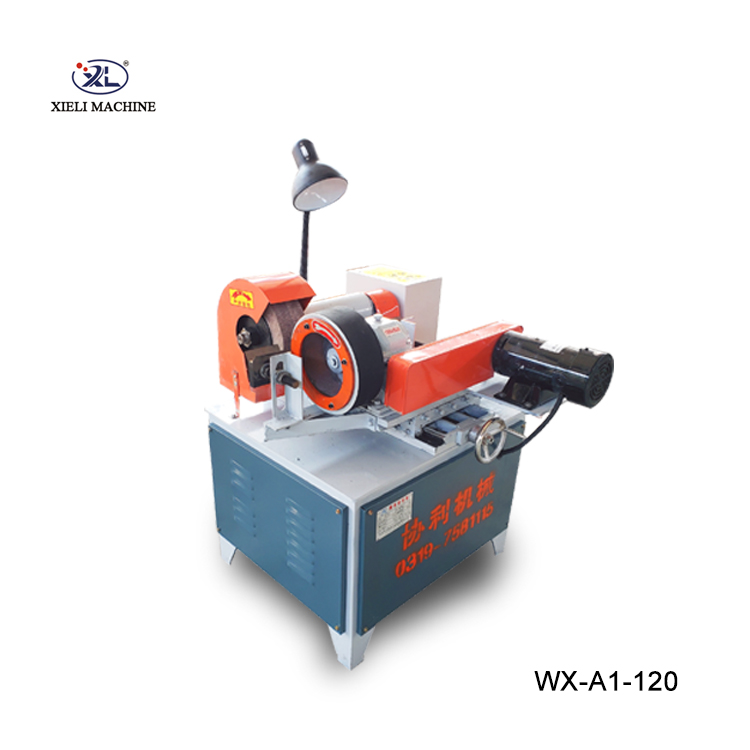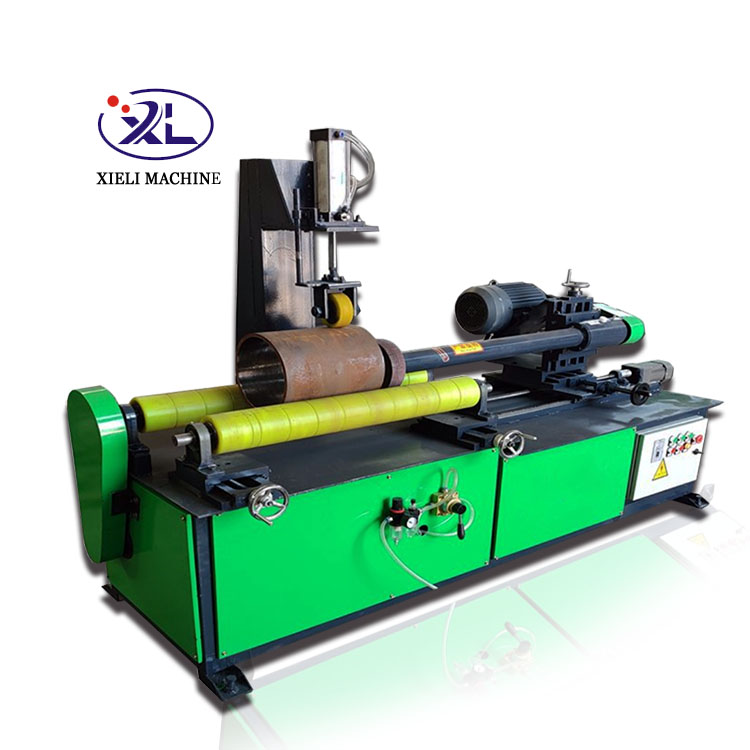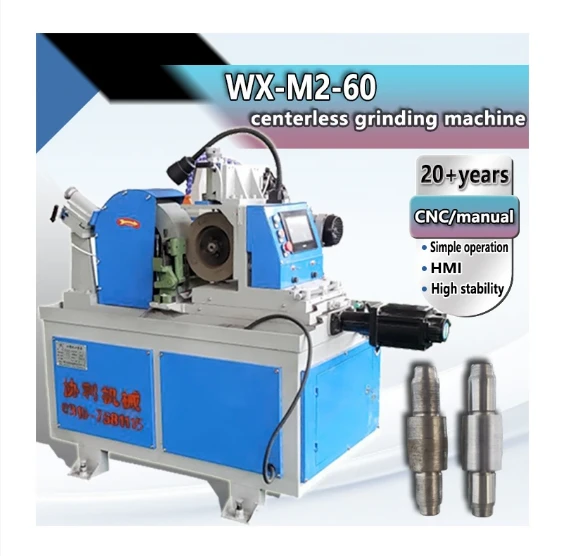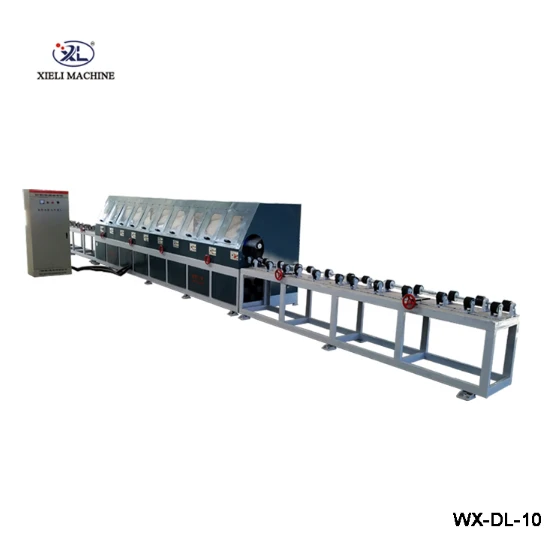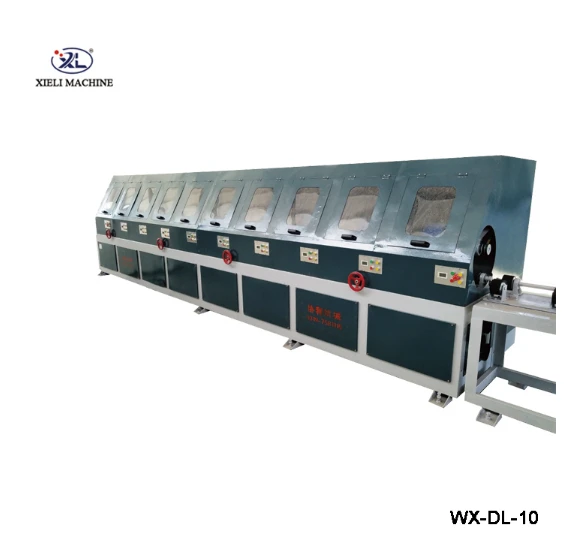The Evolution of Precision: Understanding High-Quality Centerless Belt Grinding and Polishing Machines
In today's highly competitive manufacturing landscape, the demand for unparalleled surface finish and dimensional accuracy across various industrial components is paramount. This imperative has driven significant advancements in abrasive machining technologies, particularly within the realm of centerless grinding and polishing. A high quality centerless belt grinding polishing machine stands at the forefront of this evolution, offering superior efficiency and precision for cylindrical, conical, or even flat workpieces that demand exceptional surface integrity. Unlike traditional methods, centerless systems eliminate the need for center holes or fixtures, streamlining the process and reducing setup times, which is critical for high-volume production. The industry is currently witnessing a trend towards intelligent automation, integration with IoT for predictive maintenance, and the adoption of advanced abrasive materials, all aimed at enhancing productivity and reducing operational costs. For instance, the demand for machines capable of handling exotic alloys and composite materials is rising, necessitating more robust designs and adaptable control systems. These sophisticated machines are not merely tools; they are integrated solutions that significantly contribute to the overall quality and market competitiveness of the final product, from delicate medical instruments to heavy-duty industrial shafts, ensuring compliance with stringent industry standards and client expectations. This emphasis on quality and efficiency also translates directly into a more sustainable manufacturing footprint, thanks to reduced material waste and optimized energy consumption during the grinding and polishing cycles.
The market for high-performance grinding and polishing solutions is experiencing robust growth, driven by sectors such as automotive, aerospace, medical, and general manufacturing, all requiring components with exacting tolerances and mirror-like finishes. As manufacturers push the boundaries of material science, from hardened steels to intricate ceramics, the sophistication required from a grinding and polishing machine intensifies. This includes enhanced vibration dampening, precision feedback loops, and advanced coolant management systems to prevent thermal distortion and maximize abrasive life. Suppliers are increasingly focusing on modular designs that allow for easy customization and scalability, addressing diverse application needs from fine finishing to aggressive material removal. Moreover, the integration of real-time monitoring and data analytics capabilities is transforming these machines into smart assets, enabling proactive adjustments and optimized performance. The shift towards automated loading and unloading systems further boosts throughput and reduces manual labor costs, making the investment in a superior centerless system economically viable for a wider range of businesses. Understanding these market dynamics and technological advancements is key to selecting a grinding and polishing solution that not only meets current production demands but also offers the flexibility to adapt to future challenges and opportunities within the evolving industrial landscape.
Precision Engineering: Manufacturing Process of a High-Quality Centerless Belt Grinding Polishing Machine
The creation of a high quality centerless belt grinding polishing machine is a meticulous process, demanding exceptional engineering precision at every stage, reflecting the critical role these machines play in producing high-tolerance components. The core structure, often comprising the main machine bed and grinding head, is typically fabricated from high-grade cast iron or stress-relieved steel, selected for its superior vibration damping characteristics and inherent stability. This foundational material undergoes rigorous processes such as precision casting or forging, followed by extensive annealing to relieve internal stresses, ensuring long-term dimensional stability and preventing deformation under operational loads. Subsequent stages involve multi-axis CNC machining, achieving micron-level tolerances on critical surfaces like guideways and spindle housings. For example, the precise alignment of the regulating wheel and grinding wheel is paramount, often requiring iterative machining and measurement using laser interferometry to ensure parallelism and perpendicularity within very tight specifications. All critical components, including spindles, bearings, and hydraulic systems, are sourced from certified suppliers and undergo individual material inspections to meet international standards such as ASTM or DIN.
Throughout the assembly process, adherence to stringent quality control protocols, including ISO 9001 certified manufacturing practices and ANSI B11.9 safety standards, is non-negotiable. Each machine undergoes exhaustive performance testing, including run-out tests, thermal stability tests, and grinding trials with various materials to validate its capabilities. The estimated service life of a well-maintained high quality centerless belt grinding polishing machine typically exceeds 15-20 years, a testament to the robust design and quality of components. These machines are indispensable across a broad spectrum of industries, including petrochemical for valve stems and pump shafts, metallurgy for precision rods and bars, and water supply & drainage for fittings and pipes. In these demanding environments, the machine's inherent advantages become clear: its ability to achieve mirror finishes without compromising material integrity contributes to enhanced energy efficiency in fluid dynamics by reducing surface friction on pipes and shafts, thereby lowering pumping costs. Furthermore, the superior surface finish significantly improves corrosion resistance, extending the operational life of components exposed to harsh chemicals or environments, directly mitigating costly downtime and premature component failure in critical infrastructure. The precision and consistent output provided by these machines also ensure that components meet strict regulatory compliance for safety and performance.
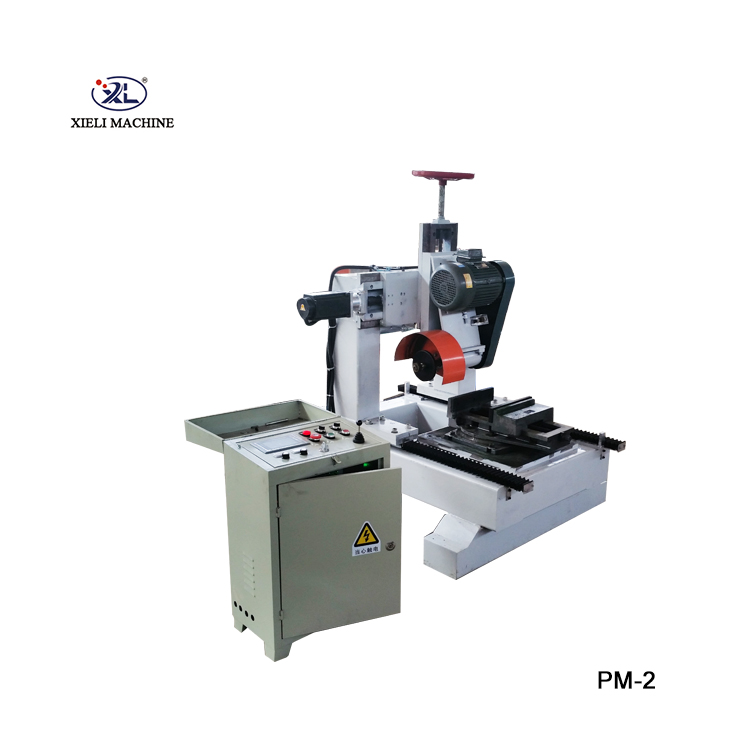 A typical manufacturing flow for such a machine involves several critical phases. It begins with the design phase, leveraging CAD/CAM systems for optimal structural integrity and kinematic performance, simulating stress points and thermal expansion. Following design approval, raw material procurement ensures compliance with specified alloy compositions and structural properties. The main machine body fabrication proceeds with precision casting or welding, followed by stress relieving heat treatments. Subsequently, the body undergoes rough and finish machining on large-scale CNC gantries to achieve foundational accuracy. Simultaneously, critical sub-assemblies like the grinding spindle unit, regulating wheel mechanism, and coolant system are manufactured, often involving specialized processes like precision grinding of spindle shafts and dynamic balancing of rotating parts. Electrical and control systems are meticulously assembled and tested for functionality and safety, incorporating advanced PLCs and HMI interfaces. The final assembly involves integrating all modules onto the main frame, followed by comprehensive functional testing, alignment checks, and calibration. Prior to dispatch, each machine undergoes a rigorous final inspection, including non-destructive testing (NDT) and performance validation against specified output parameters, ensuring that every unit delivered is a pinnacle of engineering excellence.
A typical manufacturing flow for such a machine involves several critical phases. It begins with the design phase, leveraging CAD/CAM systems for optimal structural integrity and kinematic performance, simulating stress points and thermal expansion. Following design approval, raw material procurement ensures compliance with specified alloy compositions and structural properties. The main machine body fabrication proceeds with precision casting or welding, followed by stress relieving heat treatments. Subsequently, the body undergoes rough and finish machining on large-scale CNC gantries to achieve foundational accuracy. Simultaneously, critical sub-assemblies like the grinding spindle unit, regulating wheel mechanism, and coolant system are manufactured, often involving specialized processes like precision grinding of spindle shafts and dynamic balancing of rotating parts. Electrical and control systems are meticulously assembled and tested for functionality and safety, incorporating advanced PLCs and HMI interfaces. The final assembly involves integrating all modules onto the main frame, followed by comprehensive functional testing, alignment checks, and calibration. Prior to dispatch, each machine undergoes a rigorous final inspection, including non-destructive testing (NDT) and performance validation against specified output parameters, ensuring that every unit delivered is a pinnacle of engineering excellence.
Technical Specifications and Performance Metrics: Unpacking the Power
The effectiveness of a high quality centerless belt grinding polishing machine is intrinsically linked to its technical specifications and the precision parameters it can consistently achieve. These machines are engineered to deliver not just speed but also unparalleled accuracy and surface finish. Key performance indicators include the maximum and minimum workpiece diameter it can process, typically ranging from 1mm up to 200mm, alongside the optimal workpiece length, which can extend to several meters for applications like pipe and bar polishing. The grinding belt dimensions are crucial, influencing material removal rates and surface finish. Grinding belt speeds, often adjustable via VFD (Variable Frequency Drive) for optimal cutting conditions, can reach up to 30 m/s, while regulating wheel speeds are lower, typically 0.5-20 rpm, to control workpiece rotation and feed. Power consumption is another vital metric, with main motor powers varying from 7.5 kW to 30 kW or more, depending on the machine's capacity and intended application, reflecting its energy efficiency and operational cost. Advanced control systems, frequently incorporating Siemens or Fanuc PLCs, provide precise control over grinding parameters, ensuring consistent quality and enabling complex grinding routines.
When evaluating a high quality centerless belt grinding polishing machine, it's beneficial to compare its capabilities with established industry benchmarks, such as a high quality Cincinnati centerless grinder machine, renowned for their robust construction and precision. While Cincinnati machines are celebrated for their traditional grinding wheel rigidity and heavy-duty applications, modern belt grinding systems offer superior adaptability for fine finishes and specific material types, often providing a lower initial investment and reduced abrasive consumable costs for certain applications. For instance, the flexible nature of abrasive belts allows for better conformity to irregular shapes and superior heat dissipation, reducing workpiece distortion. Below is a comparative table illustrating typical specifications for a modern centerless belt grinding and polishing machine, providing concrete data points for decision-makers in procurement and engineering. These specifications are not merely numbers; they represent the machine's capacity to deliver consistent, repeatable results, minimize scrap rates, and optimize production throughput, directly impacting the bottom line and ensuring high standards of component quality. The integration of advanced sensor technology for real-time monitoring of grinding force, vibration, and temperature further enhances process control and predictive maintenance, making these machines truly smart assets in a modern manufacturing environment.
| Parameter | Value Range / Description |
|---|---|
| Workpiece Diameter Range | Φ 1 mm - Φ 200 mm |
| Workpiece Length | Unlimited (Through-feed), up to 6000 mm (In-feed) |
| Grinding Belt Speed | 10-30 m/s (Adjustable via VFD) |
| Regulating Wheel Speed | 0.5 - 20 rpm (Variable) |
| Main Motor Power | 7.5 kW - 30 kW (or higher, application-dependent) |
| Surface Roughness Achievable | Ra 0.05 µm - 0.8 µm (depending on belt grit & material) |
| Dimensional Accuracy | ± 0.005 mm (Concentricity, Ovality) |
| Control System | PLC (Siemens, Fanuc options), HMI Touchscreen |
| Coolant System Capacity | 200 L - 500 L with Magnetic Separator/Paper Filter |
Versatile Applications and Real-World Impact: Case Studies and Customer Feedback
The adaptability and precision of a high quality centerless belt grinding polishing machine make it indispensable across a vast array of industries, transforming raw materials into high-performance components. Its capacity for both aggressive material removal and mirror-finish polishing makes it suitable for diverse applications. Consider the automotive sector, where these machines are crucial for finishing engine valve stems, piston pins, and shock absorber rods, ensuring the concentricity and surface smoothness required for optimal engine performance and longevity. In the medical device industry, the ability to achieve ultra-fine finishes on surgical instruments, implants, and needles is paramount for biocompatibility and sterility, a task where traditional methods often fall short. For larger components, such as in the heavy machinery industry, a high quality old centerless grinding machine might still be in use, but modern belt grinding systems offer significant advantages in terms of material versatility and achieving specific surface textures for hydraulic shafts or precision rollers. The continuous improvement in belt abrasives, from ceramic grains to diamond belts, expands the range of materials that can be efficiently processed, including hardened steels, titanium, and advanced ceramics, meeting the rigorous demands of contemporary engineering.
Beyond traditional cylindrical components, the technology extends its reach to specialized applications. For instance, a high quality pipe polishing machine is vital for industries requiring seamless, hygienic, or high-flow conduits, such as food processing, pharmaceuticals, and semiconductor manufacturing. These machines ensure the inner and outer surfaces of pipes meet stringent cleanliness and flow-rate specifications. Similarly, the increasing demand for aesthetic and functional finishes on structural elements has elevated the importance of a high quality square tube grinding machine and a high quality square tube polishing machine. These are specifically designed to process non-cylindrical profiles, delivering consistent finishes on all faces of square or rectangular tubes, which are common in architectural frameworks, furniture, and specialized machinery. A notable example is the processing of stainless steel tubing for cleanroom applications, where a high quality SS square tube polishing machine ensures a highly reflective, easy-to-clean surface that prevents particulate adhesion and microbial growth. Customer feedback consistently highlights significant improvements in throughput, reduction in post-processing steps, and enhanced product aesthetics and functionality due to the superior surface quality achieved. One client in the oil and gas sector reported a 30% reduction in surface friction for their stainless steel pipelines after using a high quality stainless steel pipe mirror polishing machine, leading to substantial energy savings in pumping operations. This tangible impact underscores the value proposition of investing in advanced polishing technology.
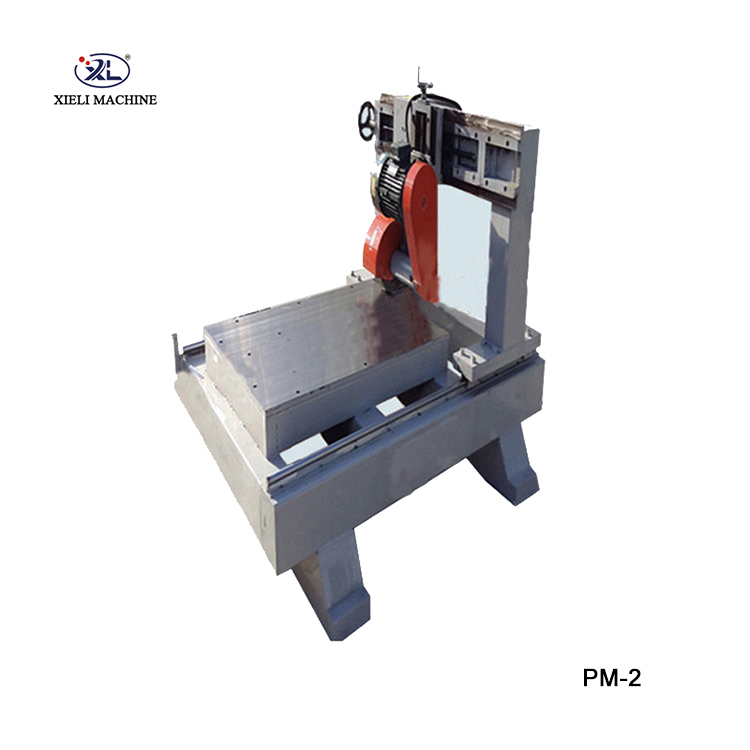 Another compelling case comes from a leading manufacturer of architectural railings and decorative components. Faced with the challenge of achieving uniform brushed or mirror finishes on various lengths of stainless steel square tubes, they integrated a dedicated high quality square tube polishing machine into their production line. Previously, this process was largely manual, inconsistent, and time-consuming, contributing significantly to labor costs and bottlenecking production. Post-implementation, they observed a 45% reduction in processing time per unit, coupled with a remarkable improvement in finish consistency and aesthetic appeal, directly enhancing their product's marketability and reducing rejection rates. This not only streamlined their operations but also allowed them to take on larger, more complex orders that were previously unfeasible due to finishing constraints. The investment in this specialized machinery rapidly paid for itself through increased efficiency and higher customer satisfaction, demonstrating the transformative potential of advanced grinding and polishing solutions in modern manufacturing environments. The adaptability of these machines also allows for quick changeovers between different material dimensions and required finishes, providing unparalleled operational flexibility.
Another compelling case comes from a leading manufacturer of architectural railings and decorative components. Faced with the challenge of achieving uniform brushed or mirror finishes on various lengths of stainless steel square tubes, they integrated a dedicated high quality square tube polishing machine into their production line. Previously, this process was largely manual, inconsistent, and time-consuming, contributing significantly to labor costs and bottlenecking production. Post-implementation, they observed a 45% reduction in processing time per unit, coupled with a remarkable improvement in finish consistency and aesthetic appeal, directly enhancing their product's marketability and reducing rejection rates. This not only streamlined their operations but also allowed them to take on larger, more complex orders that were previously unfeasible due to finishing constraints. The investment in this specialized machinery rapidly paid for itself through increased efficiency and higher customer satisfaction, demonstrating the transformative potential of advanced grinding and polishing solutions in modern manufacturing environments. The adaptability of these machines also allows for quick changeovers between different material dimensions and required finishes, providing unparalleled operational flexibility.
Choosing the Right Partner: Vendor Comparison and Customization Solutions
Selecting the ideal high quality centerless belt grinding polishing machine involves more than just reviewing technical specifications; it necessitates a thorough evaluation of potential suppliers, their expertise, and their ability to provide tailored solutions. When considering the high quality metal polishing machine price, it is crucial to look beyond the initial cost and consider the total cost of ownership (TCO), which encompasses operational efficiency, maintenance requirements, spare parts availability, and the potential for increased production output. Reputable manufacturers often provide comprehensive after-sales support, including installation, training, and troubleshooting, which can significantly impact uptime and overall productivity. It is also wise to inquire about the manufacturer's track record, service longevity, and adherence to international quality management systems like ISO 9001. Partnerships with industry leaders or specific certifications, such as those from CE or FDA (where applicable for medical device manufacturing), further validate a supplier's commitment to quality and safety. Engaging with a supplier that offers transparent pricing models and detailed breakdowns of costs, including consumables and potential upgrades, empowers informed decision-making for long-term strategic investments.
For specialized applications, the ability to procure custom solutions is paramount. While there are many general high quality pipe polishing machine suppliers, only a few possess the engineering acumen to modify or design machines for unique workpiece geometries, material properties, or specific finish requirements. Customization can involve tailored automation systems for material handling, integration with existing production lines, specialized abrasive application systems, or advanced post-processing features like automated cleaning and drying. For example, a client requiring the polishing of exceptionally long or irregularly shaped components might need a machine with extended guide systems or multi-head polishing units configured in tandem. Similarly, achieving specific Ra (Roughness Average) or Rz (Average Roughness Depth) values often requires fine-tuning of machine parameters, abrasive grit sequences, and pressure settings, which an experienced supplier can help optimize. Engaging with a supplier capable of offering comprehensive technical consultations, feasibility studies, and prototype testing ensures that the customized solution precisely meets the operational demands and delivers the desired results, providing a competitive edge in a demanding market. This collaborative approach minimizes risks associated with significant capital investments and maximizes the return on investment.
Quality Assurance, Support, and Trustworthiness: Our Commitment
At the heart of our operations lies an unwavering commitment to quality and customer satisfaction, recognizing that a high quality centerless belt grinding polishing machine is a critical asset for our clients. Every machine undergoes a rigorous multi-stage quality assurance process, beginning with the meticulous selection of raw materials from trusted suppliers, all certified to meet international standards such as ISO and CE. During manufacturing, each sub-assembly is subject to in-process inspections, utilizing precision metrology tools to ensure adherence to engineering blueprints. Before dispatch, every machine is subjected to comprehensive Factory Acceptance Testing (FAT), simulating real-world operational conditions. This includes continuous run tests, performance validation against specified surface finish and dimensional accuracy parameters, and thorough safety checks in compliance with directives like the Machinery Directive 2006/42/EC. We maintain a detailed record of all test data, which is available to clients, providing transparent insight into their machine's verified capabilities. Our service expertise spans over two decades in the grinding and polishing machinery sector, underpinned by numerous industry certifications and successful collaborations with leading manufacturing firms globally.
Understanding the critical nature of production schedules, we emphasize efficient delivery and robust after-sales support. Our typical delivery timeline for standard machines ranges from 8-12 weeks, with customized solutions requiring additional time, clearly communicated at the time of quotation. We provide a comprehensive 12-month warranty on all mechanical and electrical components, covering defects in materials and workmanship, ensuring peace of mind for our clients. Beyond the warranty period, we offer flexible service contracts, prompt spare parts availability, and remote diagnostic support to minimize downtime. Our dedicated customer support team comprises highly skilled engineers and technicians, available to assist with installation, commissioning, operational training, and ongoing technical queries. This commitment extends to providing detailed maintenance manuals and video tutorials, empowering our clients to proactively manage their machines. This holistic approach to support, combined with our proven track record and adherence to the highest manufacturing standards, solidifies our reputation as a trusted partner in precision surface finishing technology, ensuring that your investment in a high quality centerless belt grinding polishing machine yields optimal and sustained performance throughout its lifecycle.
Frequently Asked Questions (FAQ) about Centerless Grinding and Polishing Machines
-
Q1: What are the primary advantages of a centerless belt grinding machine over traditional center-type grinders?
A1: Centerless belt grinding machines offer several key advantages, including higher production rates due to continuous through-feed processing without the need for workpiece fixturing, which significantly reduces loading/unloading times. They can also achieve superior surface finishes, especially for longer workpieces, as belt conformity reduces vibration and localized heat buildup. Furthermore, these machines are often more versatile with various material types and offer lower abrasive consumable costs compared to grinding wheels for certain applications. Their inherent design also provides enhanced rigidity for precise material removal, contributing to tighter dimensional tolerances and improved concentricity.
-
Q2: How does a high quality centerless belt grinding polishing machine achieve a mirror finish?
A2: Achieving a mirror finish with a high quality centerless belt grinding polishing machine involves a multi-stage process utilizing progressively finer grit abrasive belts. The initial stages use coarser belts for material removal and surface preparation, eliminating major imperfections. Subsequent stages employ increasingly finer belts, often transitioning from silicon carbide or aluminum oxide to specialized polishing belts made with fine non-woven abrasives or even diamond slurries. Precise control over contact pressure, belt speed, and workpiece feed rate, combined with efficient cooling systems, is crucial to prevent overheating and maintain surface integrity, leading to a highly reflective, defect-free surface finish down to Ra 0.05 µm or better.
-
Q3: Can these machines process non-cylindrical workpieces like square tubes?
A3: While traditional centerless grinders are primarily for cylindrical components, modern advanced versions, particularly specialized high quality square tube polishing machine or grinding systems, are designed to process non-cylindrical profiles. These machines typically feature specialized fixtures, guiding systems, and often multiple abrasive heads configured to simultaneously grind or polish all faces of a square or rectangular tube as it passes through the machine. This ensures uniform material removal and consistent surface finish across the entire profile, making them invaluable for industries working with structural or decorative tubing. Customization is often key for such applications to ensure optimal performance and specific finish requirements.
-
Q4: What maintenance is required for a high quality centerless belt grinding polishing machine to ensure longevity?
A4: To ensure the longevity and peak performance of a high quality centerless belt grinding polishing machine, regular maintenance is essential. This includes daily checks of coolant levels and filtration systems, weekly inspection and cleaning of the abrasive belt tracking and tensioning mechanisms, and periodic lubrication of all moving parts as per the manufacturer's recommendations. Critical components like spindle bearings and hydraulic systems should be inspected annually by qualified technicians. Regular calibration of feeding mechanisms and pressure controls is also vital to maintain precision. Adhering to the recommended maintenance schedule, using genuine spare parts, and ensuring proper training for operators significantly extend the machine's service life and uphold its high quality output capabilities.
Authoritative References and Further Reading
- Journal of Manufacturing Science and Engineering - Provides research on advanced machining processes, including grinding and polishing mechanisms.
- CIRP Annals - Manufacturing Technology - Features cutting-edge papers on production engineering, surface integrity, and machine tool design.
- International Journal of Machine Tools and Manufacture - Offers insights into the design, analysis, and performance of manufacturing systems and tools.
- Precision Engineering - Dedicated to fundamental and applied research in precision manufacturing and metrology.
- ASTM International (American Society for Testing and Materials) - Publishes standards for materials, products, systems, and services relevant to manufacturing.

